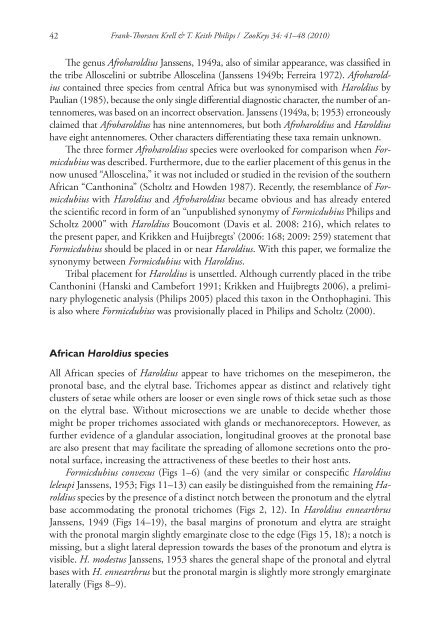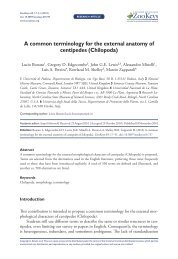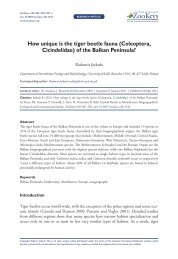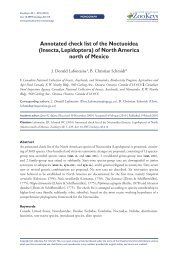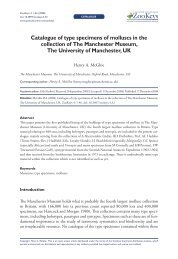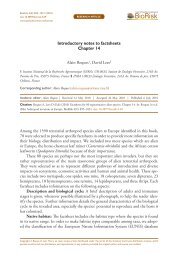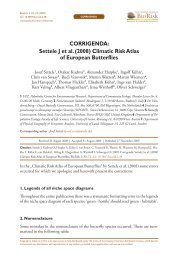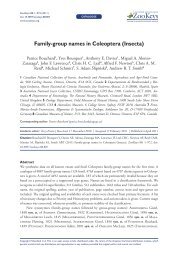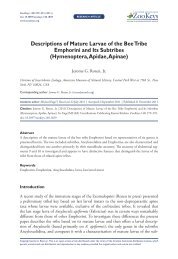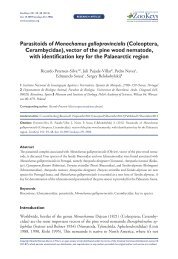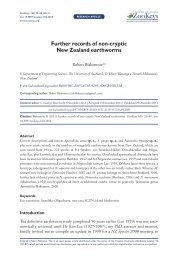Formicdubius Philips & Scholtz from South Africa, a junior synonym ...
Formicdubius Philips & Scholtz from South Africa, a junior synonym ...
Formicdubius Philips & Scholtz from South Africa, a junior synonym ...
Create successful ePaper yourself
Turn your PDF publications into a flip-book with our unique Google optimized e-Paper software.
42<br />
Frank-Th orsten Krell & T. Keith <strong>Philips</strong> / ZooKeys 34: 41–48 (2010)<br />
Th e genus Afroharoldius Janssens, 1949a, also of similar appearance, was classifi ed in<br />
the tribe Alloscelini or subtribe Alloscelina (Janssens 1949b; Ferreira 1972). Afroharoldius<br />
contained three species <strong>from</strong> central <strong>Africa</strong> but was <strong>synonym</strong>ised with Haroldius by<br />
Paulian (1985), because the only single diff erential diagnostic character, the number of antennomeres,<br />
was based on an incorrect observation. Janssens (1949a, b; 1953) erroneously<br />
claimed that Afroharoldius has nine antennomeres, but both Afroharoldius and Haroldius<br />
have eight antennomeres. Other characters diff erentiating these taxa remain unknown.<br />
Th e three former Afroharoldius species were overlooked for comparison when <strong>Formicdubius</strong><br />
was described. Furthermore, due to the earlier placement of this genus in the<br />
now unused “Alloscelina,” it was not included or studied in the revision of the southern<br />
<strong>Africa</strong>n “Canthonina” (<strong>Scholtz</strong> and Howden 1987). Recently, the resemblance of <strong>Formicdubius</strong><br />
with Haroldius and Afroharoldius became obvious and has already entered<br />
the scientifi c record in form of an “unpublished <strong>synonym</strong>y of <strong>Formicdubius</strong> <strong>Philips</strong> and<br />
<strong>Scholtz</strong> 2000” with Haroldius Boucomont (Davis et al. 2008: 216), which relates to<br />
the present paper, and Krikken and Huijbregts’ (2006: 168; 2009: 259) statement that<br />
<strong>Formicdubius</strong> should be placed in or near Haroldius. With this paper, we formalize the<br />
<strong>synonym</strong>y between <strong>Formicdubius</strong> with Haroldius.<br />
Tribal placement for Haroldius is unsettled. Although currently placed in the tribe<br />
Canthonini (Hanski and Cambefort 1991; Krikken and Huijbregts 2006), a preliminary<br />
phylogenetic analysis (<strong>Philips</strong> 2005) placed this taxon in the Onthophagini. Th is<br />
is also where <strong>Formicdubius</strong> was provisionally placed in <strong>Philips</strong> and <strong>Scholtz</strong> (2000).<br />
<strong>Africa</strong>n Haroldius species<br />
All <strong>Africa</strong>n species of Haroldius appear to have trichomes on the mesepimeron, the<br />
pronotal base, and the elytral base. Trichomes appear as distinct and relatively tight<br />
clusters of setae while others are looser or even single rows of thick setae such as those<br />
on the elytral base. Without microsections we are unable to decide whether those<br />
might be proper trichomes associated with glands or mechanoreceptors. However, as<br />
further evidence of a glandular association, longitudinal grooves at the pronotal base<br />
are also present that may facilitate the spreading of allomone secretions onto the pronotal<br />
surface, increasing the attractiveness of these beetles to their host ants.<br />
<strong>Formicdubius</strong> convexus (Figs 1–6) (and the very similar or conspecifi c Haroldius<br />
leleupi Janssens, 1953; Figs 11–13) can easily be distinguished <strong>from</strong> the remaining Haroldius<br />
species by the presence of a distinct notch between the pronotum and the elytral<br />
base accommodating the pronotal trichomes (Figs 2, 12). In Haroldius ennearthrus<br />
Janssens, 1949 (Figs 14–19), the basal margins of pronotum and elytra are straight<br />
with the pronotal margin slightly emarginate close to the edge (Figs 15, 18); a notch is<br />
missing, but a slight lateral depression towards the bases of the pronotum and elytra is<br />
visible. H. modestus Janssens, 1953 shares the general shape of the pronotal and elytral<br />
bases with H. ennearthrus but the pronotal margin is slightly more strongly emarginate<br />
laterally (Figs 8–9).


